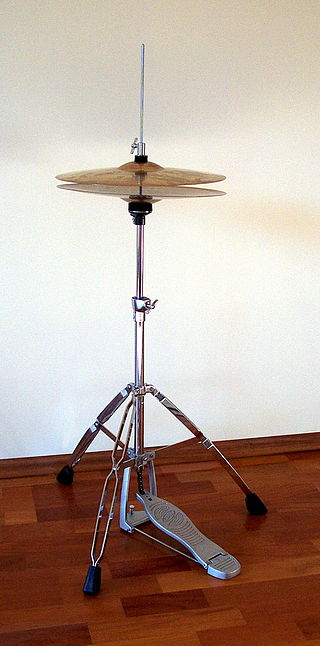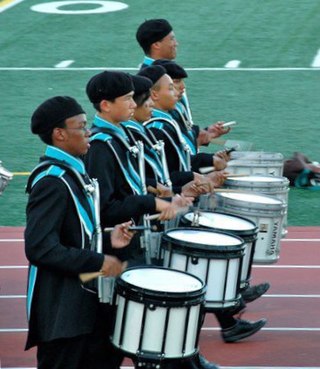Related Research Articles

A drum kit is a collection of drums, cymbals, and sometimes other auxiliary percussion instruments set up to be played by one person. The drummer typically holds a pair of matching drumsticks, and uses their feet to operate hi-hat and bass drum pedals.

A hi-hat is a combination of two cymbals and a pedal, all mounted on a metal stand. It is a part of the standard drum kit used by drummers in many styles of music including rock, pop, jazz, and blues. Hi-hats consist of a matching pair of small to medium-sized cymbals mounted on a stand, with the two cymbals facing each other. The bottom cymbal is fixed and the top is mounted on a rod which moves the top cymbal toward the bottom one when the pedal is depressed.

A percussion instrument is a musical instrument that is sounded by being struck or scraped by a beater including attached or enclosed beaters or rattles struck, scraped or rubbed by hand or struck against another similar instrument. Excluding zoomusicological instruments and the human voice, the percussion family is believed to include the oldest musical instruments. In spite of being a very common term to designate instruments, and to relate them to their players, the percussionists, percussion is not a systematic classificatory category of instruments, as described by the scientific field of organology. It is shown below that percussion instruments may belong to the organological classes of idiophone, membranophone, aerophone and chordophone.

The snare drum is a percussion instrument that produces a sharp staccato sound when the head is struck with a drum stick, due to the use of a series of stiff wires held under tension against the lower skin. Snare drums are often used in orchestras, concert bands, marching bands, parades, drumlines, drum corps, and more. It is one of the central pieces in a drum set, a collection of percussion instruments designed to be played by a seated drummer and used in many genres of music. Because basic rhythms are very easy to learn to play on a snare drum even for children, the instrument is also suitable for the music education for young children and a rhythm band.

A drummer is a percussionist who creates music using drums.

The bass drum is a large drum that produces a note of low definite or indefinite pitch. The instrument is typically cylindrical, with the drum's diameter much greater than the drum's depth, with a struck head at both ends of the cylinder. The heads may be made of calfskin or plastic and there is normally a means of adjusting the tension either by threaded taps or by strings. Bass drums are built in a variety of sizes, but size does not dictate the volume produced by the drum. The pitch and the sound can vary much with different sizes, but the size is also chosen based on convenience and aesthetics. Bass drums are percussion instruments and vary in size and are used in several musical genres. Three major types of bass drums can be distinguished.
A blast beat is a type of drum beat that originated in hardcore punk and grindcore, and is often associated with certain styles of extreme metal, namely black metal and death metal, and occasionally in metalcore. In Adam MacGregor's definition, "the blast-beat generally comprises a repeated, sixteenth-note figure played at a very fast tempo, and divided uniformly among the bass drum, snare, and ride, crash, or hi-hat cymbal." Blast beats have been described by PopMatters contributor Whitney Strub as, "maniacal percussive explosions, less about rhythm per se than sheer sonic violence".
"The 'original' or traditional blastbeat is a single-stroke roll played between your cymbal and snare, with your kick playing simultaneously with every cymbal hit."

Daniel Edwin Carey is an American musician and songwriter. He is the drummer for the American rock band Tool. He has also contributed to albums by artists such as Zaum, Green Jellö, Pigface, Skinny Puppy, Adrian Belew, Carole King, Collide, Meat Puppets, Lusk, and the Melvins.

Snare technique is the technique used to play a snare drum.

A drum roll is a technique used by percussionists to produce a sustained sound for the duration of a written note.
All drum figures are based upon three fundamental beats, technically called roll, single stroke, and flam...Sustentation is accomplished upon wind instruments by blowing into the instrument; it is accomplished upon the violin and the allied instruments by drawing the bow across the string; it is accomplished upon the drum and allied percussion instruments by the roll.
THE SNARE DRUM ROLL.
The roll consists of an even reiteration of beats sufficiently rapid to prohibit rhythmic analysis. To produce an impression of sustentation, these beats must be absolutely even both in power and in sequence. Uneven beats in a roll destroy the impression of sustentation. Evenness is then the primary quality to strive for in roll; speed is the secondary quality to strive for.
There are two possible ways of producing an absolutely even sequence: (1) hand alternation of single stroke and (2) hand alternation of double strokes...The snare drum roll is produced by hand alternation of double strokes.
The "open roll" is produced by [initially] slow hand alternation. Two strokes in each hand alternately are produced by wrist movement and each beat should follow its predecessor in clock-like precision.

A rhythm section is a group of musicians within a music ensemble or band that provides the underlying rhythm, harmony and pulse of the accompaniment, providing a rhythmic and harmonic reference and "beat" for the rest of the band. The rhythm section is often contrasted with the roles of other musicians in the band, such as the lead guitarist or lead vocals whose primary job is to carry the melody.

In rudimental drumming, a form of percussion music, a drum rudiment is one of a number of relatively small patterns which form the foundation for more extended and complex drumming patterns. The term "drum rudiment" is most closely associated with various forms of field drumming, where the snare drum plays a prominent role. In this context "rudiment" means not only "basic", but also fundamental. This tradition of drumming originates in military drumming and it is a central component of martial music.

Electronic drums are a modern electronic musical instrument, primarily designed to serve as an alternative to an acoustic drum kit. Electronic drums consist of an electronic sound module which produces the synthesized or sampled percussion sounds and a set of pads, usually constructed in a shape to resemble drums and cymbals, which are equipped with electronic sensors to send an electronic signal to the sound module which outputs a sound. Like acoustic drums, the pads are struck by drum sticks and they are played in a similar manner to an acoustic drum kit, albeit with some differences in the drumming experience.

Stephen Kendall Gadd is an American drummer, percussionist, and session musician. Gadd is one of the best-known and highly regarded session and studio drummers in the industry, recognized by his induction into the Modern Drummer Hall of Fame in 1984. Gadd's performances on Paul Simon's "50 Ways to Leave Your Lover" and "Late in the Evening" and Steely Dan's "Aja" are examples of his style. He has worked with other popular musicians from many genres including Simon & Garfunkel, James Taylor, Chick Corea, Chuck Mangione, Eric Clapton and Michel Petrucciani.
A drum beat or drum pattern is a rhythmic pattern, or repeated rhythm establishing the meter and groove through the pulse and subdivision, played on drum kits and other percussion instruments. As such a "beat" consists of multiple drum strokes occurring over multiple musical beats while the term "drum beat" may also refer to a single drum stroke which may occupy more or less time than the current pulse. Many drum beats define or are characteristic of specific music genres.
Heel-toe technique is a foot technique that drummers use to be able to play single strokes or double strokes on the bass drum, hi-hat, or other pedals.

Jazz drumming is the art of playing percussion in jazz styles ranging from 1910s-style Dixieland jazz to 1970s-era jazz fusion and 1980s-era Latin jazz. The techniques and instrumentation of this type of performance have evolved over several periods, influenced by jazz at large and the individual drummers within it. Stylistically, this aspect of performance was shaped by its starting place, New Orleans, as well as numerous other regions of the world, including other parts of the United States, the Caribbean, and Africa.
In music, the term swing has two main uses. Colloquially, it is used to describe the propulsive quality or "feel" of a rhythm, especially when the music prompts a visceral response such as foot-tapping or head-nodding. This sense can also be called "groove".
In drumming, a groove is a repeated phrase that sets and maintains the rhythm and tempo of the piece.

Heavy metal drumming is a style of rock music drum kit playing that developed in the late 1960s and early 1970s, largely in the United States and the United Kingdom. With roots in blues rock and psychedelic/acid rock drum playing, heavy metal drummers play with emphatic beats, and overall loudness using an aggressive performing style. Heavy metal drumming is traditionally characterized by emphatic rhythms and dense bass guitar-and-drum sound.
References
- 1 2 Chaffee, Gary (1993). Linear Time Playing. Miami, FL 33014: CPP/Belwin, Inc. pp. 4–7. ISBN 9780769233697.
{{cite book}}: CS1 maint: location (link) - ↑ Ribchester, Alex. "Fun 5 Beat Linear Drum Fill". Online Drummer. Retrieved 9 April 2018.
- ↑ O'Shea, Kev. "Gavin Harrison". KevOShea.com. Retrieved 9 April 2018.
- ↑ Ribchester, Alex. "Steve Gadd Linear 32nd Note Drum Lick". Online Drummer. Retrieved 9 April 2018.